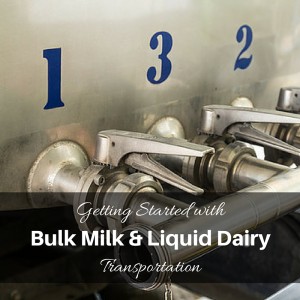April 18, 2016
Getting Started with Bulk Milk and Liquid Dairy Transportation

In addition, only small amounts could be moved at a time, given the time element connected to potential spoilage concerns and the size of the transport options. Those concerns have long since faded, but it’s important to examine exactly what constitutes this method of delivery.
Change Means More Convenience
Within this concept is bulk milk transportation, which has also seen changes from the days when it was transported exclusively in 10-gallon cans. Now, trucks possess the capacity to transport 8,000 gallons at one time.
Working in tandem with the available milk output, bulk milk transportation is most needed during the spring, when the weather is the most conducive for cows and production is at its highest. The summer months see a gradual drop-off in that production until things bottom out during the fall.
Still, the need to have milk and dairy available on a year-round basis demands that a processing plant have the ability to store excess requirements in order to properly space out its sales.
The Concerns of a New Operation
When it comes to getting a new business started in this industry, such things can be a challenge, but those concerns are reduced when a reliable outlet for bulk dairy transportation is in place. This allows a consistent delivery schedule to be put in place with contracted farms. Even if you’re part of an established business entity, a clear business plan of exactly how to safely transport these items is always a necessity.
A Quality Tanker in Place
When the milk is collected from a particular farm, it enters a cooled bulk tank that’s been carefully constructed to protect against any contamination. The milk inside each tank should be at a relatively low temperature, the lower the better.
These tanks are resistant to corrosion and non-absorbent, with the makeup of the tank crafted upon the idea that cleaning it after each run will offer both convenience and eliminate the possibility of the quality of any future product carried will be compromised.
Knowledgeable Transporters
The individual who hauls the tank should have undergone thorough training in the overall process so that there are no questions about situations that involve areas like sample collection, accurate record keeping or the aforementioned tank cleaning. That person should also be able to determine simply by sight or smell whether or not the dairy product is still viable.
In order to reduce the level of concern over where a particular truck carrying dairy items is at a certain time, location tracking technology exists for the transport company to address that issue. This can help determine if some issue could result in a delay or what the ETA for the actually delivery will take place.
The Right Choice
Having the right plan in place when it comes to bulk milk transportation is the first step toward achieving success in what can be a very competitive market.
Kan-Haul has the know-how in all aspects of bulk dairy transportation, having helped establish a benchmark for proper procedures when it comes to this vital segment of the liquid food business. It’s been this way for the last three decades, so choosing us will help any new business hit the ground running. Contact us today.



